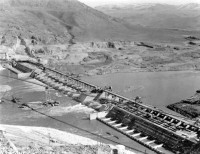Columbia Riverkeeper works with people in dozens of communities—from rural to urban—who share the same goals: Protect the health of their families and the places they love.
Case Study: Grand Coulee Dam Oil Spills

Columbia Riverkeeper (Riverkeeper) reached a settlement with the U.S. Bureau of Reclamation designed to end uncontrolled toxic oil pollution from Grand Coulee Dam, finally bringing one of the nation’s biggest dams into compliance with the Clean Water Act. Grand Coulee has leaked oil into the Columbia for over 70 years—endangering public health and threatening fish and wildlife.
The Grand Coulee Dam settlement requires the Bureau of Reclamation to join its federal partners at the Corps to investigate replacing toxic oils at Grand Coulee with eco-friendly lubricants or switch to using non-lubricated equipment. For the first time in American history, the Corps is testing eco-friendly oils in large hydroelectric dams, as required by Riverkeeper’s 2014 settlement. If the tests are successful, the Corps must switch to eco-friendly oil in eight of America’s largest dams: Bonneville, The Dalles, John Day, McNary, Ice Harbor, Lower Monumental, Little Goose, and Lower Granite. Riverkeeper’s latest settlement builds on the Corps’ investigation and could lead to similar changes at Grand Coulee Dam.



